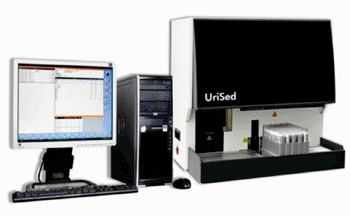Screening Tool Evaluated for Urinary Infection Diagnosis
By LabMedica International staff writers
Posted on 31 Oct 2013
A quantitative urine culture is essential for the final diagnosis of urinary tract infection (UTI), but it is time-consuming and an expensive procedure.Posted on 31 Oct 2013
Effective screening tests would be a promising alternative to provide immediate results for the clinician and eliminate unnecessary culturing for most of the negative samples.

Image: The UriSed automatic urine sediment analyzer (Photo courtesy of 77 Elektronika Kft).
Laboratory scientists at the University of Campinas (Brazil) evaluated 1,379 clean-catch midstream urine samples from inpatients and outpatients. This included 1,006 females and 373 males, age ranging from two months to 90 years, with a median age of 41 years. Three hundred ninety-nine patients (29%) had renal diseases, including kidney transplantation and functional or anatomical abnormalities of the urinary system and 8% of the cases were pregnant women.
All samples were submitted to automated sediment analysis called UriSed (77 Elektronika Kft; Budapest, Hungary) and quantitative urine culture on Cystine-Lactose-Electrolyte-Deficient Agar (CLED) (Becton Dickinson; Franklin Lakes, NJ, USA). The cut-off values for leukocyturia and significant bacteriuria were established by comparing the results obtained by UriSed and by urine culture.
From all the 1,379 analyzed urine samples, 664 of these (48%) were classified as positive for UTI by UriSed and 715 (52%) samples were classified as negative. Urine culture was positive in 13% of the samples (183/1,379). As expected, Escherichia coli was the most common microorganism isolated (84/183), followed by Klebsiella spp. (16/183) and Proteus spp. (8/183).
The sediment analyzer detected leukocyturia and/or significant bacteriuria with sensitivity of 97%, specificity of 59%, positive predictive value of 27%, negative predictive value of 99%, and accuracy of 64% at cutoff values of bacteria count equal to or greater than 12.6 elements/ high-power field (hpf) and white blood cells (WBC) equal to or greater than 6 cells/hpf. These data suggest a potential 52% reduction of unnecessary urine cultures.
The authors concluded that the UriSed system appears to be an efficient tool to rule out UTI with high sensitivity (97%) and low rate of false-negative results (1%) and thus reduce unnecessary urine cultures. However, a positive screen does not necessarily indicate UTI and should be confirmed by urine culture. The study was published on October 21, 2013, in the journal Clinica Chimica Acta.
Related Links:
University of Campinas
77 Elektronika Kft
Becton Dickinson









 Analyzer.jpg)



